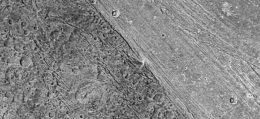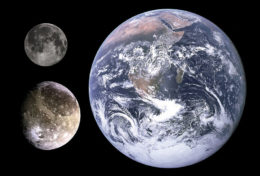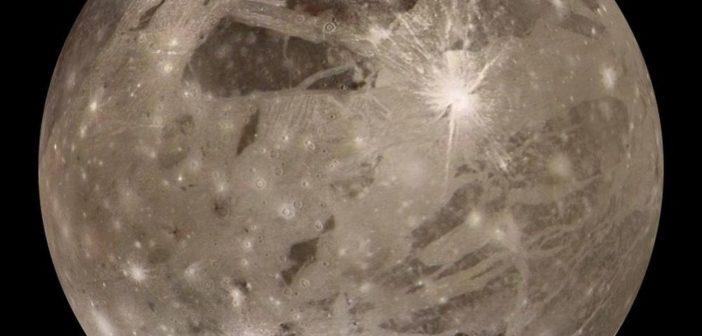Among Jupiter’s Galilean moons, icy Europa or volcanic Io often take the spotlight — but their sibling moon Ganymede has plenty of secrets to share. Powerful new millimeter observations have now provided insight into this complex satellite’s surface.
A World Apart

A sharp boundary divides the ancient dark terrain of Nicholson Regio on Ganymede from the younger, finely grooved bright terrain of Harpagia Sulcus. [NASA]
Ganymede’s complexity deepens when you look beyond its surface. Beneath its outer shell of rock and ice lurks a vast ocean that may contain more water than all of Earth’s oceans combined. What’s more, this planet-sized body (Ganymede is 26% larger than Mercury by volume!) is the only solar-system moon to produce its own, intrinsic magnetic field — which means it hosts a magnetosphere that interacts with the larger Jovian magnetosphere.

Size comparison of the Earth, the Moon (top left), and Ganymede (bottom left). [Earth: NASA; Moon: Gregory H. Revera; Ganymede: NASA/JPL/DLR]
Digging Under the Surface
This complicated satellite’s properties means that there are many different processes — originating from both its interior and its exterior — that can modify its surface. To better understand what’s happening across Ganymede’s dramatic landscape, a recent study has now leveraged the high resolution of the Atacama Large Millimeter/submillimeter Array (ALMA) to explore the top layer of this moon’s rocky, icy surface.
Scientist Katherine de Kleer (California Institute of Technology) and collaborators observed Ganymede at several different millimeter wavelengths with ALMA and then compared these data to a thermal model, examining the thermal emission of the moon from its surface down to a depth of roughly 50 cm.
From these results, the team built global temperature maps of Ganymede and explored the vertical profile of the moon’s near-surface material to identify the physical and chemical processes at play in this region.
Taking Ganymede’s Temperature
De Kleer and collaborators found that Ganymede’s material becomes rapidly less porous and more densely packed below the surface: its porosity drops from 85% at the surface to just 10% at depth. This measurement tells us how rapidly the moon’s material responds to changes in heating (for instance, daytime illumination by the Sun): the more porous surface material loses and gains heat more quickly, whereas the deeper material responds slowly.

These maps of temperature residuals, formed by subtracting the best-fit global models, show regions where Ganymede’s surface temperature deviates from prediction. The bottom map contains the same data as the top, but is overplotted on an albedo map of Ganymede’s surface. [de Kleer et al. 2021]
De Kleer and collaborators also noted larger-scale deviations in temperature — in particular, excess heat measured at the equator and cooler temperatures than predicted at middle latitudes. These differences suggest that Ganymede’s surface is predominantly influenced by external processes, like bombardment by micrometeorites and plasma on its orbit around Jupiter.
More detailed studies of Ganymede are likely in the future, and ALMA observations of Europa and Callisto are currently being analyzed — so we can expect further insight into the surfaces of these complex, icy bodies soon.
Citation
“Ganymede’s Surface Properties from Millimeter and Infrared Thermal Emission,” Katherine de Kleer et al 2021 Planet. Sci. J. 2 5. doi:10.3847/PSJ/abcbf4


3 Comments
Pingback: Elaboran mapa de temperatura global de Ganímedes para rastrear cambios en la Luna – InsurgentePress
Pingback: Magnetar Exhibits Bizarre Behavior, Identity Crisis | The Daily Space
Pingback: Ganymede Gets a Global Temperature Map | CosmoQuest